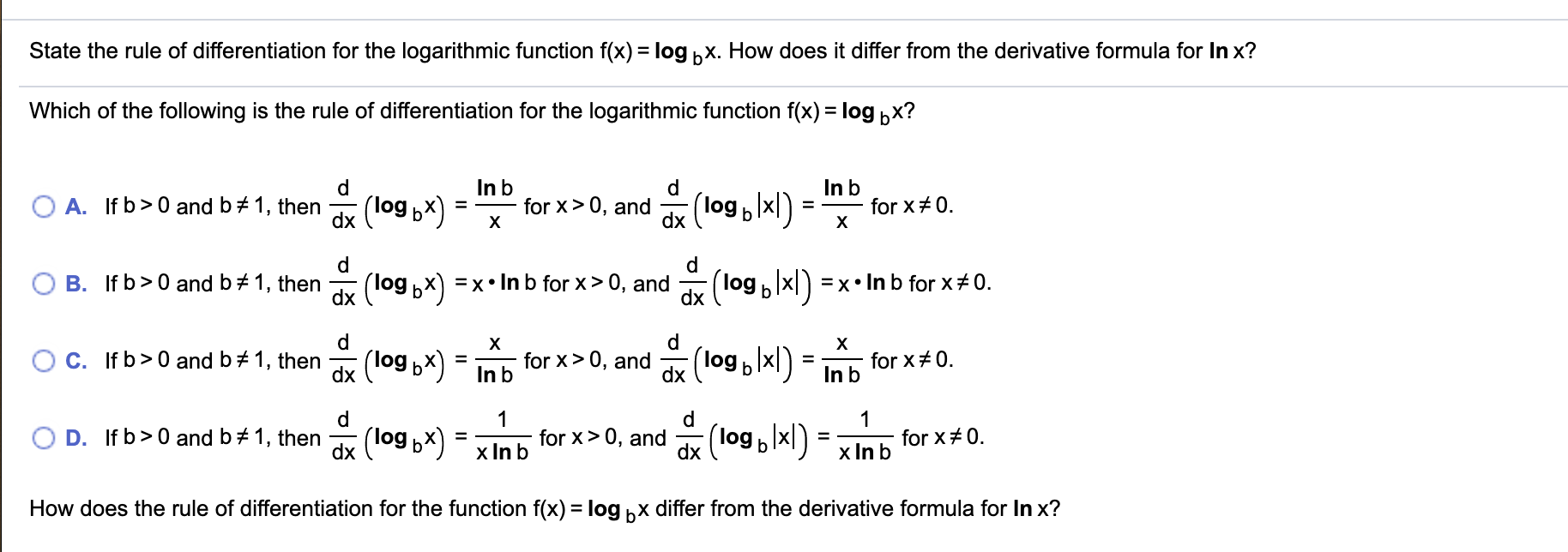



Look at some of the basic ways we can manipulate logarithmic functions: This means that there is a “duality” to the properties of logarithmic and exponential functions. d dx ln3 lnx ln3 d dx 1 lnx ln3 d dx (lnx)1 About to use the Chain Rule: d dx (lnx)1 (lnx)2 d dx lnx 1 (lnx)2 ( 1 x) y ln3 x(lnx)2. Take a moment to look over that and make sure you understand how the log and exponential functions are opposites of each other. Explanation: logx3 ln3 lnx through the change of base formula. In general, the logarithm to base b, written \(\log_b x\), is the inverse of the function \(f(x)=b^x\). Therefore, the natural logarithm of x is defined as the inverse of the natural exponential function: For example log base 10 of 100 is 2, because 10 to the second power is 100. i could not find ways to prove this in actual practice other then through the use of the calculator. Youmay have seen that there are two notations popularly used for natural logarithms, log e and ln. the change of base formula for logarithms has been derived and it all stems from the fact that any base can be represented by any other base raised to an exponent (a bc). When we take the logarithm of a number, the answer is the exponent required to raise the base of the logarithm (often 10 or e) to the original number. 1 Derivatives of exponential and logarithmic func-tions If you are not familiar with exponential and logarithmic functions you may wish to consult the booklet Exponents and Logarithms which is available from the Mathematics Learning Centre. Remember that a logarithm is the inverse of an exponential. We'll see one reason why this constant is important later on. The natural exponential function is defined as Then exponentiate both sides: e 1, we can simplify the left side of the equation to remove the exponent and natural log. This can be proved by applying implicit differentiation.

We also learn about different properties used in differentiation such as chain rule, algebraic functions trigonometric functions and inverse trigonometric functions mainly for class 12. This also includes the natural logarithmic function y ln. Review of Logarithms and Exponentialsįirst, let's clarify what we mean by the natural logarithm and natural exponential function. In this article, we will study and learn about basic as well as advanced derivative formula. While there are whole families of logarithmic and exponential functions, there are two in particular that are very special: the natural logarithm and natural exponential function.
DERIVATIVE OF LOG FORMULA HOW TO
In this lesson, we'll see how to differentiate logarithmic and exponential functions. Differentiating a Logarithm or Exponentialīy now, you've seen how to differentiate simple polynomial functions, and perhaps a few other special functions (like trigonometric functions).


 0 kommentar(er)
0 kommentar(er)
